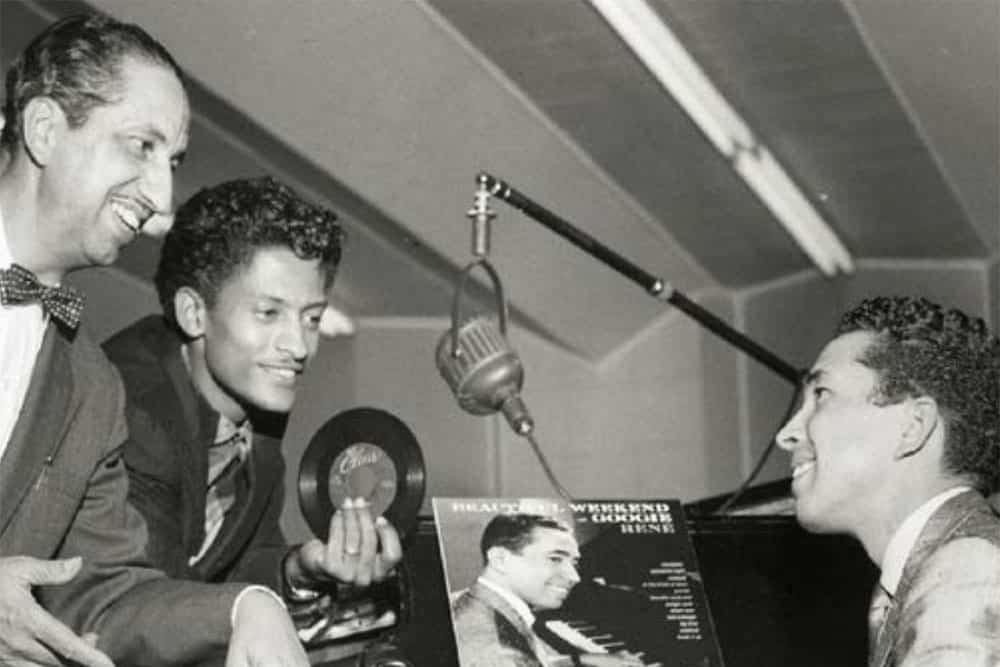
It would be folly to attempt a history of rock ‘n’ roll that didn’t make the music the star of the show. It’s what that first generation of mass-market superstars (Elvis, Chuck Berry, Little Richard, Fats Domino, etc.) did in tying together the breakthroughs and innovations of R&B, country, and blues legends (Louis Jordan, Hank Williams, Muddy Waters, to name just a few), that drew audiences all over the world into this brash new mashup of street-level style, insouciance and rhythm.
That’s as it should be: we’d much rather hear about the stars on the stage than, say, the people who constructed the stage. But rock didn’t happen entirely in an artistic vacuum. Those now-canonical artists may have written and performed the music, but they weren’t the ones who put it into the marketplace or get it heard by a legion of music fans and consumers starved for hot new sounds. Those folks were the businessmen and entrepreneurs of post-World War II American pop music, and their contributions are largely absent from most retellings of rock’s development.
Of all the first-gen rock label owners, only the handful who turned their dreams into icons (Sam Phillips and Sun Records, the Chess brothers, the Ertugen brothers and Atlantic, Berry Gordy and Motown) might be familiar to contemporary music lovers. Just beneath that upper tier of greats is another, broader level of important labels and owners that more studious fans might recognize. Beside those folks is yet another group of entrepreneurs who were the vessels for getting the music from the studio to the audience’s ears. Beyond them are even more people who parlayed a dream and a lucky strike into a nice piece of change and lots of great stories to tell. Fifty years or more after the fact, all those names are hopelessly obscure to everyone except their families and the most obsessive music trivia collectors.
John Broven’s massive labor of love gives many of these figures a few moments in the limelight. Over the decades, Broven conducted interviews with dozens of record label owners (or “record men”, and just about all of them were male), distributors, disc jockeys, song publishers and trade journalists. Record Makers & Breakers gathers up their first-hand stories to create the most in-depth road map to date of how the infrastructure of the rock music industry took shape.
Broven, a music journalist, historian and reissue producer, establishes that rock and its antecedents sprang almost entirely from independent, start-up labels. By the mid-’30s, the record industry was dominated by three labels, Victor, Colombia and Decca. But save for Decca and Louis Jordan’s proto-R&B, none of the labels sought out the burgeoning music beginning to blossom far from New York City, where the labels recorded most of their product. Broven describes a confluence of events – the establishment of BMI as a rival to the reigning music publisher ASCAP, a ban on recording aimed at protecting work for live musicians, the World War II rationing of the shellac used to make records, and the rise of the jukebox as both a venue for hearing new music and a profitable industry – that cleared the field for savvy entrepreneurs to enter the market and catch the majors flat-footed.
Broven begins with the emergence of “super-indies” Capitol and Mercury in the early ‘40s, the late-40’s rise of powerhouses Atlantic, King, Sun, Chess and Savoy, and the indie label-fueled growth of vibrant industry hubs in Los Angeles, Chicago, Nashville and New Orleans. These pioneers (many of whom were from immigrant communities, African-American, or other outsiders from mainstream industry) set the pace for the explosion of rock as both an art form and a business, and their achievements have been fairly well documented through previous histories and comprehensive CD reissues of the major artists’ music. To his credit, Broven doesn’t re-tell those stories in great detail, but draws from his treasure trove of interviews with both the big names, like Sun’s Phillips and Atlantic’s Ahmet Ertugen, and figures not before included in the annals (among many others, Atlantic co-owner Miriam Bienstock) to show how the fledgling enterprises hustled their way into the history books.
For every indie label that became a major player, there were dozens that only a serious collector would recognize today. Broven’s determined to give them their day in the sun as well; thus we’re introduced to the likes of Old Town, Bigtop and Golden Crest Records. Labels like these had their moments: you’ve probably never heard of Challenge Records, but you might have heard of their one chart release, the Champs’ “Tequila” (1958). The stories of these lesser labels and the key figures behind them aren’t included for their impact on the music, but as illustrations of how the rock industry operated. To that end, Broven also includes interviews with numerous publishers, distributors, record promoters and other behind-the-scenes businessmen, opening up a window onto a vast, diversified network of formal and informal contacts, handshake deals, and more than just a couple of questionable business practices.
As he hopscotches the country from New York to Nashville to LA and points in-between to map out the evolution of rock’s infrastructure, a general pattern emerges, both in the individual stories and Broven’s handling of them. His subjects didn’t necessarily aspire towards the business – there was no business to aspire to, no MBA program to prepare for it. They more or less found their own ways into it, and once in it, they had their good times and successes.
For his part, Broven is universally flattering towards his interviewees, most of whom he caught up with much later in their lives (in some cases, not much longer before they died). He makes no bones about this as something of a mashnote to a forgotten subset of a generation, and goes along with their winks and nods to some of the shadier business practices (payola dished out to radio jocks to get songs played, distributors keeping a few copies of hot records to sell under the table, publishing arrangements that shortchanged the artists who wrote the songs). Perhaps he had to do that during the interviews to ensure their candidness, but he makes few value judgments about those deals in print, preferring to present the full picture of the business as it existed in the ‘50s, warts and all.
Eventually, something of a narrative momentum reveals itself, as Broven moves more or less chronologically into the late ‘50s, as changing styles overcame the first wave of rock stars and many indie labels. He ends his timeline in the early ‘60s, as the payola scandal brought an end to the heyday of rock’s first entrepreneurs. But their successes had been institutionalized, as rock had been codified as big business: its products were being exported to the world, and – more crucially for the indies – the major labels had finally caught up with the gravy train. Years later, Broven finds the former hustlers all with fond memories and few regrets, mostly expansive, candid and forthright about how things were done back then. and grateful that someone gave them the chance to swing back down memory lane.
At more than 500 pages including notes and appendices, this isn’t really meant for the casual rock fan. A book focused strictly on the growth of rock as a business could easily be extracted from the source material collected here, plus the various other music industry histories and individual bios published over the years, and come in at half the length. Broven gives short shrift to jazz indies like Blue Note and Commodore, which preceded the rock era, as well as important R&B indies Duke and Vee-Jay (perhaps he never got major interviews with folks from those labels). And he’s a little premature about the death of the indie label impact on rock: it may have been on the wane when the first wave of indie entrepreneurship ran its course, but a decade or so later, a new generation of upstart labels, promoters and hustlers captured and marketed the punk, disco and rap sounds that would upend the majors’ pop hegemony.
But Broven set out to make something useful out of the volumes of material he’s collected, and the end result, full of historical details and revelations, will be a valuable resource to future pop music historians and researchers (hopefully, the actual interviews themselves will be archived somewhere). And given the current state of the music industry, there’s a little historical perspective to be gleaned: it offers detailed, historical proof that the pattern of hungry upstarts with moxie seizing on opportunities the big boys missed is hardly an Internet-era phenomenon.

